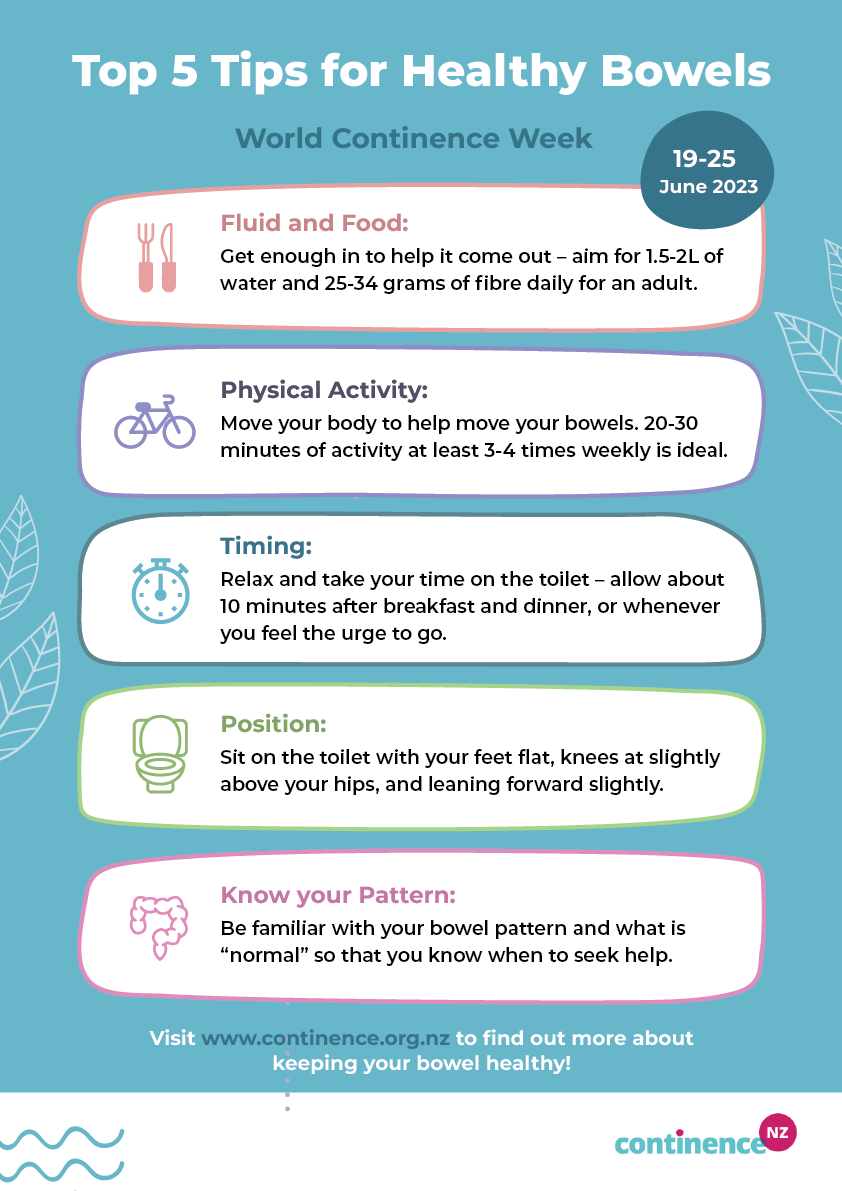Top 5 Tips for Healthy Bowels
Here are our Top 5 Tips for keeping your bowels healthy!
You will find further information on each of the tips below, along with relevant links, resources, and videos...

You can download our Top 5 Tips poster in the Downloadable Posters section.
Fluid and Food
Get enough in to help it come out – aim for 1.5-2L of water and 25-34 grams of fibre daily for an adult.
Daily water intake not only includes plain drinking water, but also water-rich foods like cucumber, tomatoes, broth, and apples, and any other fluids like warm water with honey and lemon. Try limiting caffeinated and/or sugary beverages like coffee and fizzy drinks.
Fibre-rich foods that can be incorporated into your diet include fruit (including dried fruit) like kiwifruit, vegetables, nuts, legumes (e.g., baked beans, kidney beans, soya beans), whole meal breads and cereals.
For our tamariki, the recommended daily fluid intake is about 900mls for preschool-aged children, 1200mls for younger school-aged children, and 1500mls for older school-aged children.
Relevant resources:
- Fibre & Fluid for Healthy Bowels & Bladders (downloadable resource)
- Good Food Guide (poster)
- Bowel Reviver (poster)
- For tamariki: Healthy Food colouring sheet (downloadable resource)
Physical Activity
Move your body to help move your bowels. 20-30 minutes of activity at least 3-4 times weekly is ideal.
Any form of exercise or activity that suits your abilities and lifestyle will help – anything from a brisk walk to gardening to exercising at the gym.
Movement while on the toilet can also help your bowels move and are also a good option for those who cannot exercise:
- Rubbing your tummy: press firmly in a circular clockwise motion
- Rocking back-and-forth
- Blowing, e.g., bubbles, blowing up a balloon, playing the harmonica
Relevant resources:
- Continence Tip #6: Can Exercise Help with the Bowel? (video)
- For tamariki: Sit-and-rub, sit-and-rock, sit-and-blow (1:03-3:40) (video)
Timing
Relax and take your time on the toilet – allow about 10 minutes after breakfast and dinner, or whenever you feel the urge to go.
Do not sit on the toilet for too long or strain to poo – if you do, go away for an hour then try again for another 10 minutes.
When you feel the need to poo – go, do not hold on. Do not ignore your body letting you know that it is time to go poo.
Relevant resources:
- Continence Tip #2: When Are The Best Times To Use The Toilet? (video)
- Continence Tip #3: How Often Should Someone Have a Bowel Motion? (video)
Position
Sit on the toilet with your feet flat, knees at slightly above your hips, and leaning forward slightly.
The design of modern Western toilets does not promote the optimal position for moving your bowels but using a stool to prop your feet on helps to achieve this position.
Relevant resources:
- How to Sit on the Toilet (poster)
- FAQ #5: Is there a way I can sit on the toilet to help get things going and ease my constipation? (video)
Know your Pattern
Be familiar with your bowel pattern and what is “normal” so that you know when to seek help.
What is “normal” is different from one person to the next, so it is important to know your own individual bowel pattern. Generally, a normal healthy poo is soft, easy to pass, light brown in colour, and not overly offensive smelling (#3 or #4 on the Adult Stool Chart). Most people open their bowels daily after breakfast or dinner.
Try tracking your toileting habits over a week-long period using the Bowel & Bladder Diary to become more familiar with your own pattern.
Relevant resources:
- Adult Stool Chart (poster)
- Urine Chart (poster)
- Bowel & Bladder Diary (downloadable resource)
- How do I know what is normal? (poster)
- A Healthy Bowel (webpage)
- FAQ #3: Is bowel leakage normal? (video)
- Continence Tip #3: How Often Should Someone Have a Bowel Motion? (video)
- For tamariki: Meet Mr. Poo! (video)




